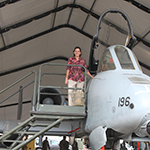Rep. Martha McSally has New Jobs Bill and good news for A-10
TUCSON – U.S. Representative Martha McSally this week introduced a new bill intended to bring more economic opportunity to our region and got some very good news for the future of the A-10.
The Sonoran Corridor Interstate Development Act would designate a key interstate corridor connecting I-10 and I-19 south of the Tucson International Airport, helping us attract more businesses to our region while expanding trade connectivity for the Southwestern United States and Mexico.
Representative McSally also released the following statement after the non-partisan Government Accountability Office (GAO) released a report citing critical flaws in the Administration’s justification for retiring the A-10 Warthog:
“Today’s (GAO) report confirms what I have worked to highlight over months of hearings: that retiring the A-10 without a replacement would create dangerous capability gaps and put American lives at risk. Not only did GAO find that divesting the A-10 would eliminate our ability to conduct Close Air Support (CAS), Combat Search and Rescue, and other critical capabilities, but that the Administration’s budget justification for doing so is based on incomplete information. While this report is welcome news, it will not eliminate the threat to the A-10, and I’m going to continue to fight to make sure we keep these vital capabilities.”
In summary, the GAO’s Preliminary Observation on A-10 Divestment states that the Air Force A-10 divestment decision came out of a strategy-based, portfolio-wide review of alternatives used to develop the budget at lower than previously anticipated levels. DOD and Air Force strategic guidance prioritized, among other things, fifth-generation aircraft such as the F-35, readiness, and multirole aircraft, while placing a lower priority on single – role aircraft like the A-10.
The report goes on to say, “In developing its fiscal year 2015 budget request, the Air Force examined its entire portfolio in light of this guidance and concluded that the benefits of divesting the A-10 outweighed the cost of retaining it. DOD reviewed and approved the Air Force A-10 divestment decision and submitted this as part of the fiscal year 2015 budget request.”
“We found that the Air Force has not fully assessed the cost savings associated with A-10 divestment or its alternatives. However, in its fiscal year 2015 budget request, the Air Force estimated that divesting the A-10 would allow it to save $4.2 billion over its 5-year budget plan. Our analysis found that the Air Force’s estimated savings are incomplete and may overstate or understate the actual figure. For example, A-10 divestment could increase the operational tempo of remaining CAS-capable aircraft, which could increase costs related to extending the service lives of those remaining CAS-capable aircraft. To the extent that this occurs, it would reduce the actual savings from the A-10 divestiture below the estimated $4.2 billion. Alternatively, savings could be greater than $4.2 billion because the Air Force estimate did not include the costs for things such as software upgrades or potential structural enhancements that it could incur if it were to keep the A-10. In presenting its budget to Congress, the Air Force provided a number of alternatives to A-10 divestment that would also result in approximately $4.2 billion in cost savings. However, these alternatives were rough estimates that were illustrative only and not fully considered as alternatives to A-10 divestment, according to Air Force officials. Without a reliable cost estimate, the Air Force does not have a complete picture of the savings it would generate by divesting the A-10 and does not have a reliable basis from which to develop and consider alternatives to achieve budget targets or assess the impact on other missions such as air superiority or global strike,” the GAO continues.
“Finally, we found that Air Force divestment of the A-10 will create potential gaps in CAS and other missions, and DOD is planning to address some of these gaps.”
Read the full report here: Preliminary Observations on Air Force A-10 Divestment – 671006.pdf
